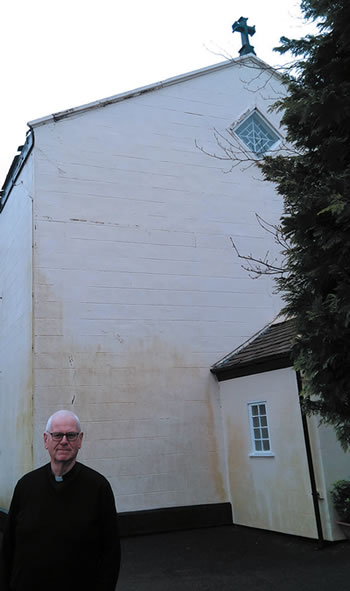
I’d passed the church three times before recognizing it. The voice of the “satnav” lady kept insisting that, “you have arrived at your destination,” but all I could see was a collection of farm buildings set in open fields. Then I noticed a cross on top of one of the buildings. This is how I finally came upon the Catholic church of St. Mary’s, near the Lancashire village of Aughton.
 I was welcomed by parish priest Fr. Des and, and after concluding the opening pleasantries, I explained the reason for my delayed arrival. “It’s your church,” I said. “It looks like a barn!”
I was welcomed by parish priest Fr. Des and, and after concluding the opening pleasantries, I explained the reason for my delayed arrival. “It’s your church,” I said. “It looks like a barn!”
“It looks like a barn because it is SUPPOSED to look like a barn,” came the reply. “It was built that way.”
Over a hot cuppa (cup of tea) Fr. Des explained the background. St. Mary’s is unusual in that it was built DURING penal times, not after. To avoid upsetting local sensibilities, and so as not to attract too much attention, it was constructed away from the village, set back from the road, shielded by trees and designed to look like a farm. “Camouflaged, in other words.” The church itself was built in the style of a barn. “That is why it has no windows.” The presbytery was given the appearance of a farmhouse.
“There are a few of these ‘barn churches’ around,” Fr. Des continued. “Not all of them are Catholic. Some are Nonconformist chapels. The Dissenters had to be discreet in those days as well.”
I’d come to St. Mary’s as part of the Columbans’ mission promotion and fundraising program and spent the weekend celebrating with the people. The parishioners are proud of their history and were eager to give me more details. It became clear that what had happened in Aughton had reflected events that occurred throughout south Lancashire during the Reformation.
In 1534 the Act of Supremacy declared Henry VIII to be head of the Church of England. Soon, Aughton’s beautiful old Parish Church of St. Michael’s was following the Protestant rite, leaving Catholics with nowhere to celebrate Mass. Indeed, it was now ILLEGAL to celebrate Mass.
Fortunately, much of the local gentry in south Lancashire kept to the “Old Faith.” They protected fellow Catholics and often arranged for secret Masses to be celebrated. Geography was a factor in this. Many villages such as Aughton were cut off from their surroundings by bogs and marshes (known locally as “mosses.”)
In Aughton’s case the lords of the manor were members of the famous Stanley family (see sidebar.) Their home at Moor Hall became a Catholic haven. Extensive renovation work carried out recently uncovered traces of a small chapel, where the Sacraments had probably been celebrated in secret. Nobility, isolation and some well-directed bribes kept the Stanleys free from arrest, although as “popish recusants” they were not immune from punishment. Local records indicate that in 1584, because his “family adhered to the old religion,” Peter Stanley was “required to furnish the cost of a light horseman accoutred” for Elizabeth I’s war in Ireland, to the tune of £24 – no mean sum at that time.
Eventually, fear of the “Catholic menace” began to abate, and in 1784 it was considered worth the risk to start celebrating the Eucharist out in the open on the site of the present church. Finally, in 1823 the faithful felt sufficiently confident to be able to build St. Mary’s, a full six years before the passing of the Act for Catholic Emancipation – albeit building the church in its disguise, and even then, leaving the doors open so that passers-by could be sure that nothing “untoward” was happening during liturgies.
Today, the parish community continues to thrive, despite St. Mary’s isolated location. People come from all over the rural area, inspired by the parish’s illustrious past. Not bad, for a church that looks like a barn.
Columban Fr. John Boles spent over 25 years on mission in South America. He is now living and working in England.
The Stanley Family
The Stanleys are one of north-western England’s best-known families.
Most notable of all was Thomas Stanley, Earl of Derby. He famously tipped the scales against Richard III at the Battle of Bosworth in 1485 by changing sides at the last minute. Shakespeare has him finding the crown under a hawthorn bush and handing it to Henry Tudor, thus ending the Wars of the Roses. Little good it did him. Henry – by then Henry VII – had him executed anyway, later in the reign. Thomas is buried in the parish church of Ormskirk, just four miles down the road from Aughton.
Another Stanley that came to a sticky end was James, who served as a prominent commander of the defeated Royalist army during the English Civil War. He had remained loyal to Charles I, and for his pains was executed in 1651 at the nearby Lancashire town of Bolton.
Peter Stanley of Aughton fought with his relative James during the Civil War and must have feared he’d suffer a similar fate after being captured by Cromwell’s Roundheads. Fortunately, he escaped with a spell in prison and recovered his estates aft er the Restoration of Charles II in 1660.